Scientific name Hyracotherium | Higher classification Palaeotheriidae | |
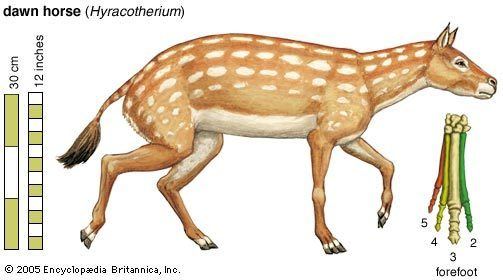 | ||
Similar | ||
Horse evolution hyracotherium
Hyracotherium (/ˌhaɪərəKOʊˈθɪəriəm, -kə-/ HY-rək-o-THEER-ee-əm; "hyrax-like beast") is an extinct genus of very small (about 60 cm in length) perissodactyl ungulates which was found in the London Clay formation. This small, dog-sized animal was once considered to be the earliest known member of Equidae before the type species, H. leporinum, was reclassified as a palaeothere, a perissodactyl family basal to both horses and brontotheres. The remaining species are now thought to belong to different genera, such as Eohippus, which had previously been synonymised with Hyracotherium.
Contents
- Horse evolution hyracotherium
- Life size hyracotherium eohippus sculpture
- Description
- Discovery
- Taxonomy and evolution
- References
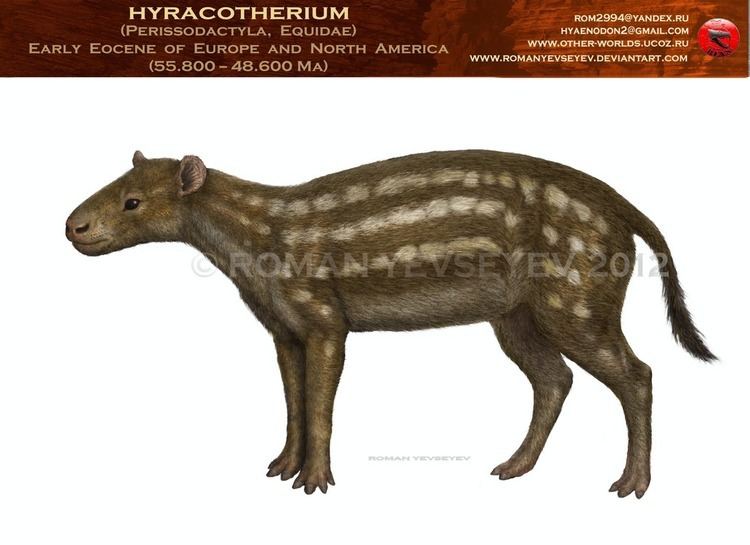
Life size hyracotherium eohippus sculpture
Description
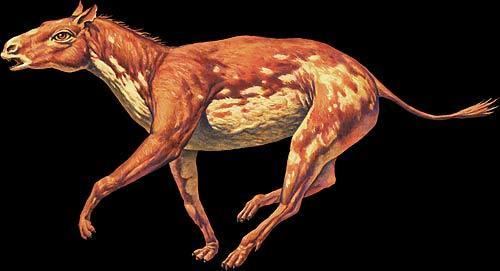
Hyracotherium averaged 78 cm (2.5 feet) in length and weighed about 9 kg (20 pounds). It had four-hoofed toes on each front foot and three-hoofed toes on each hind foot. Each toe had a pad on its underside, similar to those of a dog. It had a short face with eye sockets in the middle and a short diastema (the space between the front teeth and the cheek teeth). The skull was long, having 44 low-crowned teeth. Although it had low-crowned teeth, the beginnings of the characteristic horse-like ridges on the molars can be seen. Hyracotherium is believed to have been a browsing herbivore that ate primarily soft leaves as well as some fruits and nuts and plant shoots.
Discovery
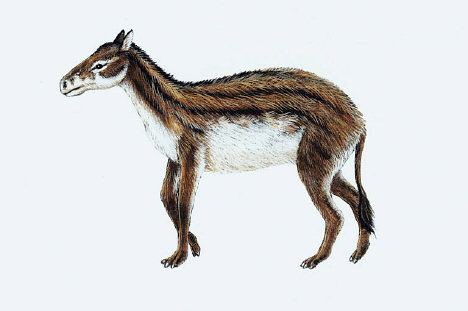
The first fossil identified as being of this genus, holotype specimen BMNH M16336, was found in the cliffs of Studd Hill near Herne Bay, Kent, and described by the paleontologist Richard Owen in a paper read to the Geological Society of London on 18 December 1839 as a "small mutilated cranium about the size of that of a hare". He identified it as belonging to an extinct order of Pachydermata, with teeth resembling those of the Chseropotamus and the general form of the skull "partaking of a character intermediate between that of the hog and the hyrax, though the large size of the eye must have given to the physiognomy of the living animal a resemblance to that of the Rodentia." Referring to this resemblance to the hyrax, Owen proposed the genus name Hyracotherium for this new genus. In his formal description published by the Geological Society in 1841, Owen wrote "Without intending to imply that the present small extinct Pachyderm was more closely allied to the Hyrax than as being a member of the same order, and similar in size, I propose to call the new genus which it unquestionably indicates, Hyracotherium, with the specific name leporinum."
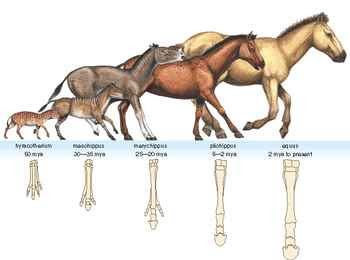
In 1876 in America Othniel C. Marsh found a full skeleton, which he placed in another new genus Eohippus, from the Greek ηώς (eōS, "dawn") and ιππος (hippos, "horse"), meaning "dawn horse". Its similarities with the fossils described by Owen were formally pointed out in a 1932 paper by Sir Clive Forster Cooper. The only species E. angustidens was moved to the genus Hyracotherium, which had priority as the name for the genus, with Eohippus becoming a junior synonym of that genus. Many other North American equids were subsequently classified as species of Hyracotherium as well, but this synonymy has recently been questioned.
Taxonomy and evolution

The type species, H. leporinum, is now regarded as a paleothere, rather than a horse proper. Most other species of Hyracotherium are still regarded as equids, but they have been placed in several other genera, such as Arenahippus, Minippus, Sifrhippus, Xenicohippus, Pliolophus, Protorohippus and the resurrected Eohippus. At one time, Xenicohippus was regarded as an early brontothere. The main stream of horse evolution occurred on the North American continent.
